Doppelganger

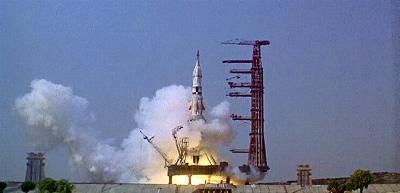
Doppelganger was Gerry Anderson's first attempt to move from children's puppet series like Thunderbirds to live action science fiction for adults.
Filming began at Pinewood Studios on 1 July 1968, in J and K stages. In September, the unit filmed on location in Portugal for 2 weeks (the Andersons had a holiday home in Portugal, and Derek Meddings had filmed back projection plates for Thunderbirds Are Go (1966) in Portugal). The exteriors of the "Eurosec" offices were Elstree Studios Neptune House, which was headquarters of ATV and later used as the film studios in UFO. SFX filming was at the Slough studios, where the puppet series were made.
Thanks to Marcus Lindroos and Shaqui Le Vesconte
In the movie, a new planet is found in the solar system by the European Space Exploration Centre's "Sunprobe", whose instruments are unexpectedly distracted by the planet's magnetic field. Images transmitted to Earth by Sunprobe reveal the new planet is in the same orbit as Earth but on the opposite side of the sun (the same arrangement found in the Space: 1999 episode The Last Enemy).
EUROSEC's autocratic chairman Jason Webb (Patrick Wymark) lobbies the European Space Exploration Council for a manned "Phoenix" follow-on mission to the new planet, but EUROSEC members France and Germany balk at the cost. The U.S. government also refuses Webb's initial call for participation in the Phoenix project but changes its mind when it is discovered that a spy has been sending classified information about the new planet to America's enemies.

The Council then reluctantly approves the project after NASA agrees to contribute $1 billion in return for putting America's top astronaut on the mission -- Glenn Ross (Roy Thinnes) who already has two Mars missions under his belt. The other crewmember is EUROSEC project director and astrophysicist John Kane (Ian Hendry). Webb has to move the launch forward by two weeks due to budget troubles in Germany and political problems in France, despite concerns Kane will not be able to complete his astronaut training in time.
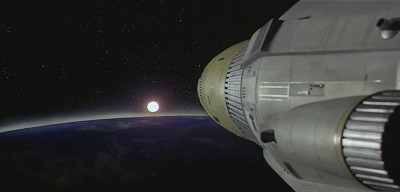
The Phoenix spacecraft is sent to the new planet, and initially enters a preliminary parking orbit. The astronauts conduct electronic surveys from space, but the orbital path only takes the spacecraft over the polar areas and oceans. The crew therefore decides to land using the "Dove" landing craft to search for life, but the ship crashes. The one survivor (Ross) is astonished to find he is back on Earth, and he is accused of turning back by his EUROSEC superiors. He then realises that everything is reversed; the planet is a mirror image of Earth.
The stars were British actor Ian Hendry (top-billed in the British print of the film), American actor Roy Thinnes (top-billed in the US print) and Patrick Wymark. The screenplay was by Gerry & Sylvia Anderson and Donald James (who also wrote The Exiles, Journey to Where, and The Seance Spectre). It was directed by Robert Parrish.
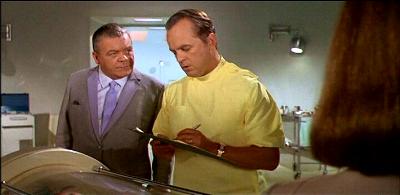
Several supporting actors later appeared in Space:1999 as well. Philip Madoc (Dr.Pontini in the movie ) played Commander Anton Gorski in Breakaway.
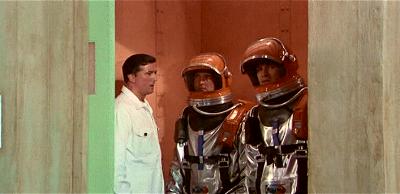
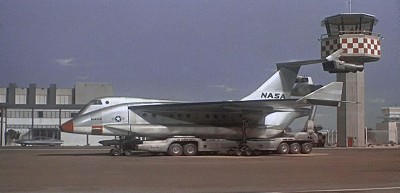
The movie is supposedly set a century in the future (2069, according to the first draft screenplay) but this is never stated on screen. The 2069 date is strongly contradicted by the late-1960s fashions, computer technology and the Phoenix rocket itself, which suggest the events take place in the near future. Later script versions mention the Phoenix rocket being "20 to 30 years" more advanced than the 1960s Saturn V technology, indicating a 1990s setting. The Phoenix rocket launch and mission control footage was later reused in the UFO episode "The Man Who Came Back", suggesting that Doppelganger is in fact contemporary with the TV series which was set in 1980-1984.
The leading Western space agencies seem to be EUROSEC and NASA. EUROSEC appears to be a successor to the real-life European Launcher Development Organisation which was initiated in the early 1960s by the UK, France, Germany, Italy, Belgium and the Netherlands; the same countries are represented in Doppelganger's EUROSEC council meeting. Britain continues to be the largest financial contributor (in real life, France and Germany overtook Britain in the 1970s when the European Space Agency and its new French-led Ariane rocket project replaced the earlier British-led ELDO I & II launch vehicle development efforts). EUROSEC maintains a huge European Space Exploration Complex in Portugal, which serves as a launch site for the giant "Phoenix" rocket.
Some sequences of the movie were shot in southern Portugal. An instruction in the script states the Airport Control Tower, where the plane carrying Glenn and Sharon Ross lands, is to 'match Faro Airport' (the capital of the southern Algarve region of Portugal). A more likely location for the launch base would be the Portuguese Atlantic islands such as the Azores, due to the danger of falling rocket stages.
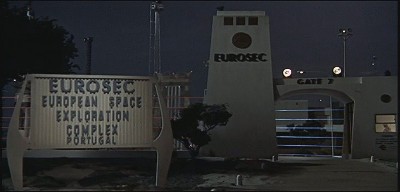
Two planets in the same orbit but on opposite sides of the sun would maintain their relative positions only if there were no other planets in the solar system (the gravitational perturbances caused by other planets would quickly disturb the orbit). Astronomers would also be able to indirectly detect the presence of a "Doppelganger" Earth as its gravity would affect the predicted positions of Mars and Venus in particular.
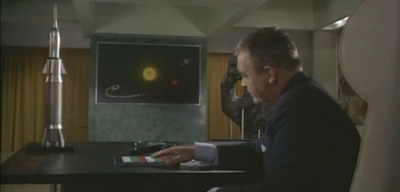
As portrayed in the movie, the curving transfer trajectory from one planet to the other should take exactly one year rather than three weeks (the position of the planets on the map does not change).
The fast three-week transfer would require an impossibly fast spacecraft capable of reaching a speed of 2% of the speed of light (i.e. 150km/s to leave Earth, 150km/s to enter an orbit around the Doppelganger planet plus another 300km/s for the 3-week return journey)! The spacecraft would essentially move in a straight line from one planet to the other.
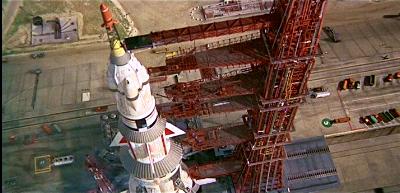
The 3-stage Phoenix carrier rocket appears to be similar to the real-life Saturn V rocket but it is much wider, suggesting larger propellant tanks and an even larger payload capability. Dialogue in the script states the rocket is actually 465 feet tall - 100 feet taller than a Saturn V. The launch vehicle appears to be constructed from clustered propellant tanks; the stabiliser fins on the second stage suggest the upper portion of the rocket is capable of independent missions with a reduced payload. The USSR made similar proposals in the 1960s with the N-1/N-11/N-111 and R-56 series of modular heavy-lift rockets.

The Phoenix mothership life support system includes a "heart/lung/kidney machine" for keeping its suspended crew alive during the 3-week interplanetary transfer phase. Heart-lung machines are frequently used in heart surgery and can also be used for the induction of body hypothermia, a state in which the hibernated body can be maintained without blood flow. However, it is currently impossible to maintain this state for longer than a few hours.

The EUROSEC "Dove" landing craft seems to be a 2-man single-stage-to-orbit (SSTO) lifting body vehicle. The design itself is quite realistic, but the Dove appears to be way too small to hold the enormous propellant tanks required for such a mission. The vehicle apparently uses VTOL jet engines for takeoff and landing.
Doppelganger set the pattern for much of Anderson's live action science fiction. The special effects and gadgetry were outstanding. However, there are a few shaky blue-screen shots, and the effects aren't in the same league as 2001: A Space Odyssey, released the previous year. As typical in Anderson productions, it all ends in spectacular explosions, when the spaceship crashes into a rocket launch pad.
The scientific basis of the plot is dubious. But any criticism is pedantic; the clever idea is the film's strongest point. Criticism of the wooden acting and slow pace are more justified. There are tedious subplots about spying and the marital problems of Thinnes which drag out the running time. Thinnes is uncharismatic and the characters are dull, although Wymark makes an impression as the autocratic boss. Yet the unsympathetic characters contribute to the general mood of paranoia and remoteness (Stanley Kubrick did the same in 2001). Apart from some soap opera aspects the film engages the viewer, although the fashions and acting style give the film a very 1960s feel.
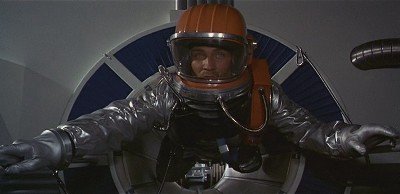
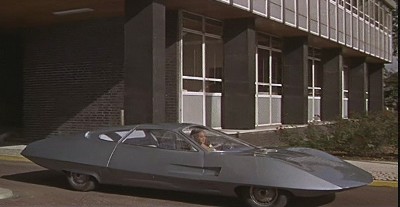
Many of the supporting actors found their way into the next Anderson production, UFO, including Ed Bishop and George Sewell. Some of the cars and jeeps made for the film also appeared in UFO, as well as some of Barry Gray's music and some stock special effects. The spacesuits became Moonbase spacesuits, and one helmet eventually ended up in the Space: 1999 episode Mission Of The Darians. The EUROSEC launch countdown timer (visible above the large world map in the mission control room) would later appear on the B&W video monitors in several year 1 Space:1999 episodes, e.g. Collision Course. Apart from that, the movie did not leave its mark on Space:1999 although the earlier UFO series benefited enormously from the expensive SFX props and costumes originally made for Doppelgänger.
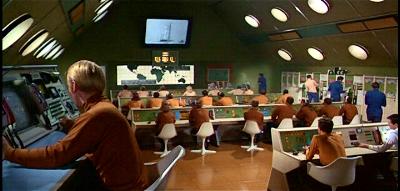
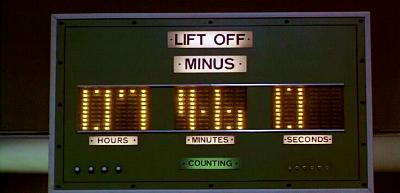
The film was released in the US on 27 August 1969 under the title, Journey To The Far Side Of The Sun.

In the UK on 8 October 1969 under the title Doppelgänger. The UK cinema release was in Odeon cinemas, and lasted just 6 days, in a double bill with another Richard Widmark film, Death of a Gunfighter. This was the only country to use the title, and the poster has to explain it, which would not have helped sell the film. The sloping text of the title would later be re-used for Space: 1999


Apollo 11 landed on the Moon on 20 July 1969 (Apollo 12 followed in November), so while space flight was topical, real-life drama overshadowed the film, in these press adverts.

Even the Australian release (poster here) used the US title. Most of the posters used artwork, rather than photos. The art prominently featured an Apollo command-service module (CSM) which is not in the film, but was featured in another film, Marooned, released in December 1969. The EVA space walk from the CSM was featured in Marooned, but does not occur in Journey To The Far Side Of The Sun.





The French release was titled Danger, planète inconnue (Danger Unknown Planet), and unusually featured photos from the film. The Danish release was Rumrejsen Bag Solen (space journey beyond the sun) and the Spanish Más allá del sol (Beyond the Sun). Both these featured the Apollo CSM as the main artwork

The German title was Unfall im Weltraum ("Accident in space"), with the Apollo CSM (with three main engines).

Viagem ao Outro Lado do Sol was released on 23 October 1969 in Portugal. It would be shown on TV on SIC on 17 April 1996




The Belgian release (Au-Dela Du Soleil in French, Achter de Kim van de Zon in Flemish Dutch), and the Italian release, Doppia Immagine Nello Spazio. Italian and Belgian posters feature different artwork, with a Gemini-type capsule and a space station, also nothing to do with the film. The red space-suited figure is the air-sea rescue member from the film (briefly).

It was released in Poland in 1974 under the title Po drugiej stronie słońca ("On the other side of the sun"). The poster, featuring Lynn Loring, was designed by Polish artist Jan Młodożeniec.
All TV prints have used the US title. It was first shown on UK television in Granada on 7 December 1974 with other regions showing the film in 1975-1977. There was a UK-wide broadcast on 31 March 1986, in which the the mirror scenes were flopped the right way round. It was released on DVD in 1998 (US only), and remastered in 2008. A Blu-ray was released in 2015.
Contents copyright Martin Willey.
Doppelganger copyright Universal